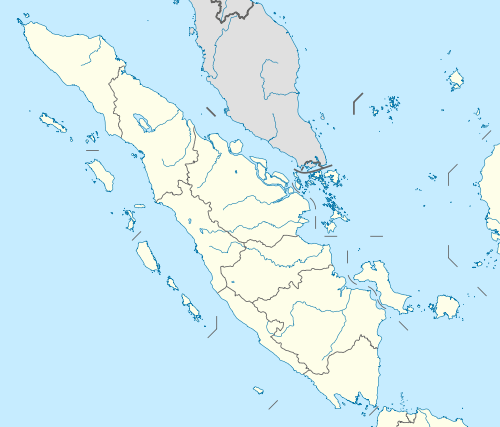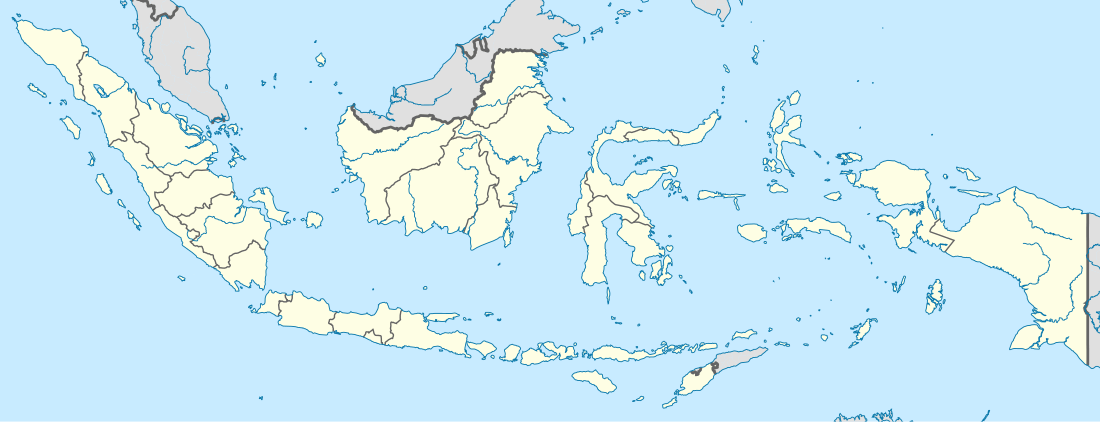Palembang
Palembang (Indonesian pronunciation: [paˈlɛmbaŋ]) is the capital city of the Indonesian province of South Sumatra. The city proper covers 400.22 square kilometres (154.53 square miles) of land on both banks of Musi River on the eastern lowland of southern Sumatra, with an estimated population of 1,834,344 in 2019.[4] Palembang is the second most populous city in Sumatra, after Medan, the ninth most populous city in Indonesia, and the nineteenth most populous city in Southeast Asia. The Palembang metropolitan area comprises part of regencies surrounding the city such as Banyuasin, Ogan Ilir, and Ogan Komering Ilir, with a total estimated population of more than 3.5 million in 2015.[5]
Palembang | |
|---|---|
| City of Palembang Kota Palembang | |
| Regional transcription(s) | |
| • Jawi | ڤلامبڠ |
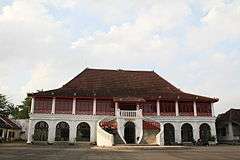 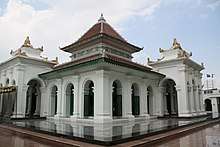 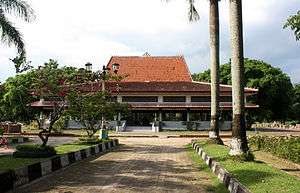 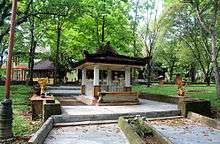 | |
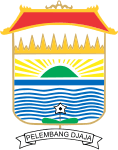 Coat of arms | |
| Nickname(s): Kota Pempek (City of Pempek), Venetië Van Andalas, Bumi Sriwijaya (The Land of Srivijaya) | |
| Motto(s): Palembang BARI (Bersih, Aman, Rapi, Indah) (Palembang: Clean, Safe, Neat, and Beautiful) | |
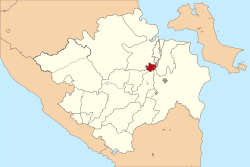 Location within South Sumatra | |
| Coordinates: 2°59′10″S 104°45′20″E | |
| Country | |
| Province | |
| Founded | 16 June 683 (Kedukan Bukit Inscription) |
| Incorporated | 1 April 1906 (Staatsblad 1906:126) |
| Government | |
| • Mayor | Harnojoyo (Demokrat) |
| • Vice Mayor | Fitrianti Agustinda |
| Area | |
| • Total | 400.22 km2 (154.53 sq mi) |
| Elevation | 8 m (26 ft) |
| Population (2019) | |
| • Total | 1,843,344 |
| • Density | 4,600/km2 (12,000/sq mi) |
| Demonym(s) | Palembangnese |
| Demographics | |
| • Ethnic groups[1] | Malays Lampung Batak Sundanese Acehnese Chinese Arab Indian |
| • Religion[2] | Islam 92.53% Buddhism 3.67% Protestant 2.23% Catholic 1.49% Hinduism 0.06% Confucianism 0.02%.[3] |
| Time zone | UTC+7 (Indonesia Western Time) |
| Postal code | 301xx, 302xx |
| Area code | (+62) 711 |
| Website | palembang.go.id |
Palembang is the one of the oldest cities in Southeast Asia. It was once the capital city of Srivijaya, a powerful Buddhist kingdom that ruled many parts of the western Indonesian Archipelago and controlled many maritime trade routes, especially in the Strait of Malacca.[6] The earliest evidence of the city's existence dates from the 7th century; a Chinese monk, Yijing, wrote that he visited Srivijaya in the year 671 for 6 months. The first inscription in which Srivijaya was mentioned, Kedukan Bukit Inscription which was found in the city also dates from the 7th century.[7] Palembang was incorporated into the Dutch East Indies in 1825 after the abolishment of the Palembang Sultanate.[8] It was chartered as a city on 1 April 1906.[9]
Palembang is mostly known by many Indonesians for Ampera Bridge, the city main landmark and pempek, one of Indonesian famous snack hailed from the city.[10] Palembang is the host city of the 2011 Southeast Asian Games and 2018 Asian Games along with Jakarta.[11][12][13] The first light rail system in Indonesia was operated in Palembang in July 2018.[14] Despite these, Palembang is still not among the most favorite tourist destinations in Indonesia.[15] The city is also not well known in the world and has poor number of foreign tourists as it attracted only 9,850 foreign tourists of the 2,011,417 tourists who visited Palembang in 2017.[16] Traffic jams, floods, slums, pollution, and peatland fire are the most well known problems in Palembang.[17][18][19][20][21]
Etymology
The etymology of the city's name is still under dispute. Some believe that the name is derived from the word limbang in Malay. By adding the prefix pe- which indicates a place or situation, the city's name means "a place to pan gold and diamond ores". It is said that during antiquity, the ruler ordered gold and diamond miners to pan their ores in the city for security and surveillance reasons.[22]
Others claim that the name comes from the word lembang in Malay. By adding the same prefix, the city's name means "a place where the water leaks".[23] It also means "a place which was constantly inundated by water". It refers to the geographical features of Palembang, which is a wetland.[24]
Some say that the name was given by four brothers who survived a shipwreck near Musi River during the Majapahit reign. It is said that on their way to a new colony in eastern Sumatra, when their ship was wrecked, all belongings in the ship sunk into the sea except a broken wooden box which the survivor used as rafts. The rafts were wobbled (limbang-limbang) by the waves until they drifted ashore to a land which was later named Palimbang by them.[25]
Palembang also has a special Chinese character rendition like several cities in Indonesia. In Chinese, Palembang is written as 巨港 (pinyin: Jùgǎng; lit.: 'giant port'). It refers to the city in the past which was once a bustling major port in Southeast Asia.[26]
History
Srivijaya period

The Kedukan Bukit Inscription, which is dated 682 AD, is the oldest inscription found in Palembang. The inscription tells of a king who acquires magical powers and leads a large military force over water and land, setting out from Tamvan delta, arriving at a place called "Matajap," and (in the interpretation of some scholars) founding the polity of Srivijaya. The "Matajap" of the inscription is believed to be Mukha Upang, a district of Palembang.[27]
According to George Coedes, "in the second half of the 9th century Java and Sumatra were united under the rule of a Sailendra reigning in Java...its centre at Palembang."[28]:92
As the capital of the Srivijaya kingdom, this second oldest city in Southeast Asia has been an important trading centre in maritime Southeast Asia for more than a millennium. The kingdom flourished by controlling the international trade through the Strait of Malacca from the seventh to thirteenth century, establishing hegemony over polities in Sumatra and the Malay Peninsula. Sanskrit inscriptions and Chinese travelogues report that the kingdom prospered as an intermediary in the international trade between China and India. Because of the Monsoon, or biannual seasonal wind, after getting to Srivijaya, traders from China or India had to stay there for several months waiting the direction of the wind changes, or had to go back to China or India. Thus, Srivijaya grew to be the biggest international trade centre, and not only the market, but also infrastructures for traders such as lodging and entertainment also developed. It functioned as a cultural centre as well.[29] Yijing, a Chinese Buddhist pilgrim who stayed in today's Palembang and Jambi in 671, recorded that there were more than a thousand Buddhist monks and learned scholars, sponsored by the kingdom to study religion in Palembang. He also recorded that there were many "states" under the kingdom called Srivijaya (Shili Foshi).[30][31]
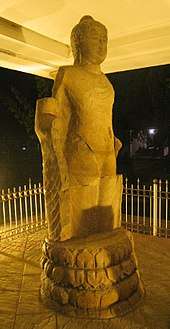
In 990, an army from the Kingdom of Medang in Java attacked Srivijaya. Palembang was sacked and the palace was looted. Cudamani Warmadewa, however, requested protection from China. By 1006, the invasion was finally repelled. In retaliation, Srivijaya king sent his troops to assist King Wurawari of Luaram in his revolt against Medang. In subsequent battles, Medang Palace was destroyed and the royal family of Medang executed.[32]
In 1068, King Virarajendra Chola of the Chola Dynasty of India conquered what is now Kedah from Srivijaya.[33] Having lost many soldiers in the war and with its coffers almost empty due to the twenty-year disruption of trade, the reach of Srivijaya was diminished. Its territories began to free themselves from the suzerainty of Palembang and to establish many small kingdoms all over the former empire.[34] Srivijaya finally declined with the military expedition by Javanese kingdoms in the thirteenth century.[31]
Post-Srivijaya period
Prince Parameswara fled from Palembang after being crushed by Javanese forces,[35] The city was then plagued by pirates, notably Chen Zuyi and Liang Daoming. In 1407, Chen was confronted at Palembang by the returning imperial treasure fleet under Admiral Zheng He. Zheng made the opening gambit, demanding Chen's surrender and the pirate quickly signalled agreement while preparing for a surprise pre-emptive strike. But details of his plan had been provided to Zheng by a local Chinese informant, and in the fierce battle that ensued, the Ming soldiers and Ming superior armada finally destroyed the pirate fleet and killed 5,000 of its men. Chen was captured and held for public execution in Nanjing in 1407. Peace was finally restored to the Strait of Malacca as Shi Jinqing was installed as Palembang's new ruler and incorporated into what would become a far-flung system of allies who acknowledged Ming supremacy in return for diplomatic recognition, military protection, and trading rights.[36][37]
Palembang Sultanate period
After Demak Sultanate fell under Kingdom of Pajang, a Demak nobleman, Geding Suro with his followers fled to Palembang and established a new dynasty. Islam become dominant in Palembang since this period.[35] Grand Mosque of Palembang built in 1738 under the reign of Sultan Mahmud Badaruddin I Jaya Wikrama,[38] completed in 1748.[39] Settlement flourished along Musi River bank, some of houses built on rafts.[35] The Sultanate enacted legislation that portion downstream of Seberang Ilir where the palace was located, was intended for residents of Palembang, whereas foreigners who were not citizens of Palembang was at the opposite bank of the palace called Seberang Ulu.[40]
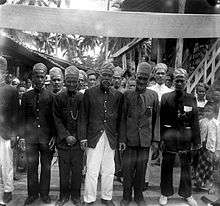
Several local rivals, such as Banten, Jambi, and Aceh threatened the existence of the Sultanate, meanwhile Dutch East India Company established a trade post in Palembang in 1619. In 1642, the company obtained monopoly right over pepper trading in the port. Tension mounted between the Dutch and the locals, peaked at 1657 when a Dutch ship was attacked in Palembang, gave a signal to the company to launch a punitive expedition in 1659 which burned the city to the ground.[35]
.svg.png)
During Napoleonic Wars in 1812, the sultan at that time, Mahmud Badaruddin II repudiated British claims to suzerainty, which was responded by British by attacking Palembang, sacking the court, and installing sultan's more cooperative younger brother, Najamuddin to the throne. The Dutch attempted to recover their influence at the court in 1816, but Sultan Najamuddin was uncooperative with them. An expedition launched by the Dutch in 1818 and captured Sultan Najamudin and exiled him to Batavia. A Dutch garrison was established in 1821, but sultan attempted an attack and a mass poisoning to the garrison, which were intervened by Dutch. Mahmud Badaruddin II was exiled to Ternate, and his palace was burned to the ground. The Sultanate was later abolished by Dutch and direct colonial rule was established.[35]
Colonial period
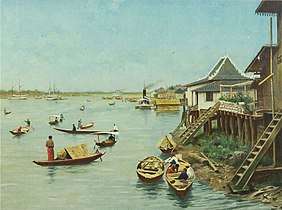
Since the abolition of the Palembang Sultanate in 1825 by the Dutch, Palembang become the capital of Residency of Palembang, encompassing whole territory who will be South Sumatra province after independence, led by Jan Izaäk van Sevenhoven as its first resident.[8]
From the late nineteenth century, with the introduction of new export crops by the Dutch companies, most notably robusta coffee, Palembang rose again as an economic centre. During early 20th century, the development of the petroleum and rubber industries in Palembang Residency caused unprecedented economic growth to the city, which brought about the influx of migrants, an increase in urbanisation, and development of the socioeconomic infrastructure, brought the residency into one of the "three giants" in the export economy of the Netherlands East Indies, together with the East Sumatran Plantation Belt and Southeast Kalimantan in the 1930s. In addition, Palembang became the most populous urban centre outside Java during that time.[41]
Japanese occupation period
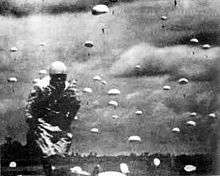
Palembang was a high priority objective for Japanese forces, because it was the location of some of the finest oil refineries in Southeast Asia. An oil embargo had been imposed on Japan by the United States, the Netherlands, and the United Kingdom. With the area's abundant fuel supply and airfield, Palembang offered significant potential as a military base area, to both the Allies and the Japanese.[42][43]
The main battle occurred during 13–16 February 1942. While the Allied planes were attacking Japanese shipping on 13 February, Kawasaki Ki-56 transport planes of the 1st, 2nd and 3rd Chutai, Imperial Japanese Army Air Force (IJAAF), dropped Teishin Shudan (Raiding Group) paratroopers over Pangkalan Benteng airfield. At the same time Mitsubishi Ki-21 bombers from the 98th Sentai dropped supplies for paratroopers. The formation was escorted by a large force of Nakajima Ki-43 fighters from the 59th and 64th Sentai. As many as 180 men from the Japanese 2nd Parachute Regiment, under Colonel Seiichi Kume, dropped between Palembang and Pangkalan Benteng, and more than 90 men came down west of the refineries at Plaju. Although the Japanese paratroopers failed to capture the Pangkalan Benteng airfield, at the Plaju oil refinery they managed to gain possession of the entire complex, which was undamaged. However, the second oil refinery in Sungai Gerong was successfully demolished by the Allies. A makeshift counter-attack by Landstorm troops and anti-aircraft gunners from Prabumulih managed to retake the complex but took heavy losses. The planned demolition failed to do any serious damage to the refinery, but the oil stores were set ablaze. Two hours after the first drop, another 60 Japanese paratroopers were dropped near Pangkalan Benteng airfield.[42][43]
As the Japanese landing force approached Sumatra, the remaining Allied aircraft attacked it, and the Japanese transport ship Otawa Maru was sunk. Hurricanes flew up the rivers, machine-gunning Japanese landing craft. However, on the afternoon of 15 February, all Allied aircraft were ordered to Java, where a major Japanese attack was anticipated, and the Allied air units had withdrawn from southern Sumatra by the evening of 16 February 1942. Other personnel were evacuated via Oosthaven (now Bandar Lampung) by ships to Java or India.[42][43]
The Japanese managed to restore production at both main refineries, and these petroleum products were significant in their war effort. Despite Allied air raids, production was largely maintained.
In August 1944 USAAF B-29 bombers, flying from India, raided the Palembang refineries in what was the longest range regular bombing mission of the war.[44]
In January 1945, in Operation Meridian, the British Royal Navy Fleet Air Arm launched two major attacks on the two refinery complexes, against determined Japanese defence.[45]
National revolution period
On 8 October 1945, Resident of South Sumatra, Adnan Kapau Gani with all Gunseibu officers raised the Indonesian flag during a ceremony. On that day, it was announced that Palembang Residency was under control of Republicans.[46]
Palembang was occupied by Dutch after an urban battle between the Republicans and the Dutch on 1–5 January 1947, which is nicknamed Pertempuran Lima Hari Lima Malam (Five Days and Nights Battle). There were three fronts during the battle which are Eastern Ilir front, Western Ilir front, and Ulu front. The battle ended with ceasefire and the Republican forces was forced to retreat as far as 20 kilometres (12 miles) from Palembang.[47][48]
During the occupation, the Dutch formed the federal state of South Sumatra on September 1948.[49] After the transfer of sovereignty on 27 December 1949, South Sumatra State, along with other federal states and the Republic had formed short-lived United States of Indonesia before the states were abolished and integrated back into the form of Republic on 17 August 1950.[50]
Old Order and New Order period
During PRRI/Permesta rebellion, the rebel faction established Dewan Garuda (Garuda Council) in South Sumatra on 15 January 1957 under Lieutenant Colonel Barlian took over the local government of South Sumatra.
In April 1962, Indonesian government started the construction of Ampera Bridge which was completed and officially opened for public on 30 September 1965 by Minister/Commander of the Army Lieutenant General Ahmad Yani on 30 September 1965, only hours before he was killed by troops belonging to the 30 September Movement. At first, the bridge was known as the Bung Karno Bridge, after the president, but following his fall, it was renamed the Ampera Bridge.[51] A second bridge in Palembang which crosses Musi River, Musi II Bridge was built on 4 August 1992.[52]
On 6 December 1988, Indonesia government expanded Palembang's administrative area as far as 12 kilometers from the city center, with 9 villages from Musi Banyuasin integrated into 2 new districts of Palembang and 1 village from Ogan Komering Ilir integrated into Seberang Ulu I District.[52]
During May 1998 riots of Indonesia, Palembang was also ravaged by riots with 10 burned shops, more than a dozen burned cars, and several injured people inflicted by rioters as students marching to the Provincial People's Representative Council office of South Sumatra. Thousands of police and soldiers were put on guard at various points in the city. The Volunteer Team for Humanity (Indonesian: Tim Relawan untuk Manusia, or TRUK) reported that cases of sexual assault also took place.[52]
Reformasi period
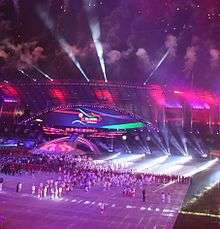
In 1998, a sport complex along with its main stadium, Gelora Sriwijaya Stadium, was built in Jakabaring, completed in 2004. It served as venues for 2004 Pekan Olahraga Nasional. Palembang became host of Pekan Olahraga Nasional in 2004 after 47 years it was last held outside Java and 51 years in Sumatra.[53] 7 years later, Palembang became the host of the 2011 Southeast Asian Games along with Jakarta. In 2013, Indonesian government decide to replace the host of 2013 Islamic Solidarity Games from Pekanbaru to Palembang because several problems occurred in the former host, including Riau Governor, Rusli Zainal who stumbled over a corruption scandal.[54] Palembang, together again with Jakarta, hosted the 2018 Asian Games.[55]
Sixth president of Indonesia, Susilo Bambang Yudhoyono, declared Palembang as a "Water Tourism City" on 27 September 2005.[56] More further on 5 January 2008, Palembang publicised its tourist attractions with the slogan "Visit Musi 2008".[57]
Palembang completed its first flyover at Simpang Polda in September 2008.[58] Second flyover in Jakabaring completed in 2015.[59] In 2010, Palembang launched its bus transit system, Transmusi.[60] Since 2015, Indonesian government began to upgrade Palembang's transportation capability with the construction of Indonesia's first light rail transit system from Sultan Mahmud Badaruddin II International Airport to Jakabaring, the city's toll roads, two Musi River bridges, and two flyovers, all expected to be operational before 2018 Asian Games.[61][62][63] The toll road began its operation in October 2017.[64]
Geography and climate
Geography
At 2°59′10″S 104°45′20″E, Palembang occupies 400.61 km2 of vast lowland area east of Bukit Barisan Mountains in southern Sumatra with average elevation of 8 metres (26 feet),[65] approximately 105 kilometres (65 miles) from nearby coast at Bangka Strait. One of the largest rivers in Sumatra, the Musi River, runs through the city, dividing the city area into two major parts which are Seberang Ilir in the north and Seberang Ulu in the south. Palembang is also located on the confluence of two major tributaries of Musi River, which are Ogan River and Komering River. The river's water level is influenced by tidal cycle. In rainy season, many areas on the city are inundated by the river's tide.[66]
Palembang's topography is quite different between Seberang Ilir and Seberang Ulu area. Seberang Ulu topography is relatively flat, meanwhile Seberang Ilir topography is more rugged with altitude variation between 4 and 20 metres (13 and 66 feet).[66]
Climate
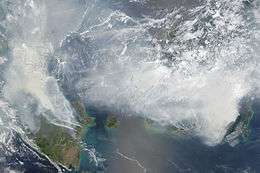
Palembang is located in the tropical rainforest climate (Köppen Af) with significant rainfall even in its driest months. The climate in Palembang is often described with "hot, humid climate with a lot of rainfall throughout the year". The annual average temperature is around 27.3 °C (81.1 °F). Within tropical climate, except for precipitation and monsoonal wind direction, the city experiences no other seasonal change throughout the year. Average rainfall annually is 2,623 millimetres.[67] During its wettest months, the city's lowlands are frequently inundated by torrential rains. However, in its driest months, many peatlands around the city dried, making them more vulnerable to wildfires, causing prolonged haze in the city. Due to the city very low latitude, typhoon risk of the city is nearly absent.[68]
| Climate data for Palembang | |||||||||||||
|---|---|---|---|---|---|---|---|---|---|---|---|---|---|
| Month | Jan | Feb | Mar | Apr | May | Jun | Jul | Aug | Sep | Oct | Nov | Dec | Year |
| Average high °C (°F) | 30.8 (87.4) |
31.2 (88.2) |
31.5 (88.7) |
32.1 (89.8) |
32.4 (90.3) |
31.9 (89.4) |
31.8 (89.2) |
32.1 (89.8) |
32.5 (90.5) |
32.6 (90.7) |
31.9 (89.4) |
31.1 (88.0) |
31.8 (89.3) |
| Daily mean °C (°F) | 26.8 (80.2) |
27.1 (80.8) |
27.2 (81.0) |
27.7 (81.9) |
28.0 (82.4) |
27.4 (81.3) |
27.0 (80.6) |
27.2 (81.0) |
27.5 (81.5) |
27.7 (81.9) |
27.4 (81.3) |
27.0 (80.6) |
27.3 (81.2) |
| Average low °C (°F) | 22.9 (73.2) |
23.0 (73.4) |
23.0 (73.4) |
23.4 (74.1) |
23.6 (74.5) |
22.9 (73.2) |
22.3 (72.1) |
22.4 (72.3) |
22.5 (72.5) |
22.9 (73.2) |
23.0 (73.4) |
23.0 (73.4) |
22.9 (73.2) |
| Average precipitation mm (inches) | 277 (10.9) |
262 (10.3) |
329 (13.0) |
263 (10.4) |
213 (8.4) |
122 (4.8) |
104 (4.1) |
107 (4.2) |
120 (4.7) |
186 (7.3) |
274 (10.8) |
366 (14.4) |
2,623 (103.3) |
| Mean monthly sunshine hours | 169 | 118 | 130 | 150 | 174 | 127 | 130 | 149 | 118 | 160 | 132 | 120 | 1,677 |
| Source 1: Climate-Data.org[69] | |||||||||||||
| Source 2: Deutscher Wetterdienst[70][71] | |||||||||||||
Neighborhoods

Palembang is roughly divided by Musi River into two major areas known as Seberang Ilir (lit. "downstream bank") in the north and Seberang Ulu (lit. "upstream bank") in the south. Seberang Ilir is the main economic and political centre in Palembang and contained a prominent portion of the city's highrises. Seberang Ulu is undergoing massive development, especially in Jakabaring, with the construction of business centre, government building, and the most notably is the construction of the city's sport complex, Jakabaring Sport City.
Administration
Government
Palembang is administratively has a status as a city and has its own local government and legislative body. The executive head of Palembang is the Mayor. The mayor and members of representatives are locally elected by popular vote for a 5-year term. The city government enjoys greater decentralization of affairs than the provincial body, such as the provision of public schools, public health facilities and public transportation. Current Mayor of the city is Harnojoyo, previous vice mayor who is appointed because the previous mayor, Romi Herton was impeached because of a bribery scandal during his election.[72] Besides Mayor and Vice Mayor, there is Palembang Municipal People's Representative Council, which is a legislative body of council members directly elected by the people in legislative elections every five years.
Administrative Division
Palembang consists of eighteen kecamatan (districts),[73] each headed by a Camat. They are further divided again into 107 kelurahan (urban villages):[74]
| District | Area (km2) | Total population Census 2010 |
Total population (2015) |
Population Density
(per km2) in 2015 |
|---|---|---|---|---|
| Ilir Barat II | 6.22 | 63,959 | 65,991 | 10,609 |
| Gandus | 68.78 | 57,221 | 62,146 | 904 |
| Seberang Ulu I | 17.44 | 162,744 | 176,749 | 10,135 |
| Kertapati | 42.56 | 80,226 | 84,698 | 1,990 |
| Seberang Ulu II | 10.69 | 92,276 | 99,222 | 9,282 |
| Plaju | 15.17 | 79,096 | 81,891 | 5,398 |
| Ilir Barat I | 19.77 | 124,657 | 135,385 | 6,848 |
| Bukit Kecil | 9.92 | 43,811 | 43,967 | 4,432 |
| Ilir Timur I | 6.50 | 69,406 | 71,418 | 10,987 |
| Kemuning | 9.00 | 82,661 | 85,002 | 9,445 |
| Ilir Timur II | 25.58 | 159,152 | 165,238 | 6,460 |
| Kalidoni | 27.92 | 99,738 | 110,982 | 3,975 |
| Sako | 18.04 | 82,661 | 91,087 | 5,049 |
| Sematang Borang | 51.46 | 32,207 | 37,434 | 1,012 |
| Sukarami | 36.98 | 139,098 | 164,139 | 3,190 |
| Alang Alang Lebar | 34.58 | 86,371 | 105,168 | 3,041 |
| Ilir Timur III | - | - | - | - [a] |
| Jakabaring | - | - | - | - [a] |
Demography
Ethnicity and language
Palembang is an ethnically diverse city. The indigenous population in the region of Palembang are Palembangnese people, a subgroup of Malay people heavily influenced by Javanese culture. Many of them live in traditional settlements along the Musi River bank, although there has been a recent efflux of Palembangnese to the outer suburbs. Many people of other ethnicities from other parts of South Sumatra and beyond also live in Palembang. There is also a significant Arab and Chinese Indonesian communities who are inhabitants of Palembang.[1] Arab Indonesian communities mainly live in several villages such as Kampong Al Munawwar in 13 Ulu, Kampong Assegaf in 16 Ulu, Kampong Al Habsyi in Kuto Batu, Kampong Jamalullail in 19 Ilir and Kampong Alawiyyin in Sungai Bayas, 10 Ilir. Conversely, Chinese Indonesian communities mainly live in commercial districts in Palembang although there are several traditional Chinese villages like Kampong Kapitan in 7 Ulu.
The local language of Palembang, Musi (Bahasa Palembang), is considered a dialect of Malay with a significant portion being Javanese loanwords. The natives originating from other parts of South Sumatra have their own regional languages, such as Komering, Lahat, Rawas and Semendo. Chinese languages are also largely used by local Chinese communities.
Religion
Palembang officially recognizes six religious faiths, of which the most widely held is Islam. According to the 2017 data from Badan Pusat Statistik Palembang, the population of Palembang was 92.22% Muslim, 3.91% Buddhist, 2.23% Protestant, 1.49% Roman Catholic, 0.13% Hindu, and 0.02% Confucianist. Muslims in Palembang are mainly from the Shafi`i school of Sunni Islam.[78][2] There are several mosques with considerable heritage and historical significance, chiefly the Great Mosque of Palembang, which was built during the Palembang Sultanate era, widely regarded as the main mosque of Palembang.
Transportation
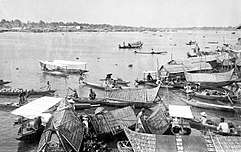
Before the operational of Ampera Bridge, there were more people in Palembang using water transportation. Large water vehicles such as river steamboat was used to transport people to and from inland. Some people also used smaller boat such as Kajang boat, a traditional boat with simple roof to carry people and goods. Nowadays, people in Palembang prefers road transportation over water one and private transportation over public one. Traffic jam often occurred in some main streets, especially during rush hour. Rail and air transportation is also available in Palembang.[79]
Road
Transmusi
Since introduced in 2010, bus rapid transit becomes the main transportation in Palembang under the name Transmusi. Transmusi has no special lanes because the road in Palembang are too narrow to build it, so Transmusi often trapped in traffic jams. Transmusi has operated 8 routes (corridors) inside the city and 3 routes to and from the city.
- Corridor 1 : Bus stop below the Ilir part of Ampera Bridge – Alang Alang Lebar Bus Station (KM 12)
- Corridor 2 : Perumnas Bus Station – PIM (Palembang Indah Mall)
- Corridor 3 : Plaju – PS Mall (Palembang Square Mall)
- Corridor 4 : Jakabaring – Karya Jaya Bus Station (Kertapati)
- Corridor 5 : Alang Alang Lebar Bus Station (KM 12) – Sultan Mahmud Badaruddin II International Airport
- Corridor 6 : Pusri – Palembang Square (PS)
- Corridor 7 : Kenten – Dempo
- Corridor 8 : Alang Alang Lebar Bus Station (KM 12) – Terminal Karya Jaya (Kertapati)
- Pangkalan Balai Corridor : Alang Alang Lebar Bus Station (KM 12) – Pangkalan Balai
- Indralaya Corridor : Terminal Karya Jaya – Indralaya
- Unsri Corridor : Unsri Bukit – Unsri Indralaya
Public bus and angkot services
Palembang operates several bus and angkot routes. First angkots in Palembang were using Willys Jeep and was called "Mobil Ketek" because of its engine sound. Public bus was introduced in 1990s and served some routes from Seberang Ilir neighborhoods such as Km.12, Perumnas, Pusri, and Bukit Besar to Seberang Ulu neighborhoods which are Kertapati, Plaju, and Jakabaring. Because of aging vehicles and complaints in security and driver habits, Palembang public bus is planned to be removed gradually until 2018.
Palembang also operates several air-conditioned public bus to neighboring towns such as Kayuagung, Indralaya, Pangkalan Balai, Prabumulih, and Tanjung Api-Api.
Taxicab
Palembang also has a large number of taxis. The number has been rising since the National Games 2004 and SEA Games 2011, which both were held in Palembang.
Becak and ojek
There are many becak (pedicabs) and ojek (motorcycle taxi) operated in Palembang. Becak are often found in more older settlements along Musi River than ojek which are mostly found in more recent settlements far from the river.
App-based taxi and ojek
Taxis and ojeks are available via Go-Jek and Grab. Because of protests from taxi drivers, angkot and ojek are often barred from taking passengers to/from some places, such as the airport.
Rail
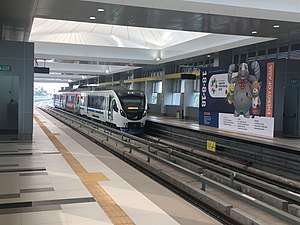
Railway tracks were introduced by the Dutch in late 1800s. Railway tracks connect Palembang to provinces in southern Sumatra such as Bandar Lampung in Lampung Province, Rejang Lebong Regency in Bengkulu Province, and some main towns in South Sumatra such as Lubuklinggau, Prabumulih, Indralaya, Muara Enim, Lahat, Tebing Tinggi, Baturaja, and Martapura. The largest railway station in Palembang is Kertapati Station. There are plans to connect Palembang to other cities in Sumatra, ultimately connected existing railways in northern, western and southern Sumatra, forming Trans Sumatra Railway.
Palembang currently is the only indonesian city (until the open of Jakarta LRT in 2019) that has the Light rail system (and metro-like system in general). This rail transit was open at 1 August 2018 and became the first rail rapid transit in Indonesia. There is 13 stations for the LRT system, connecting Sultan Mahmud Badaruddin II International Airport and Jakabaring Sport City.[80]
Water
River transport
Palembang has several types of river transportation. The most traditional one is a motorboat called "perahu ketek", a wooden boat which using small engine and moves quite slow. Perahu ketek is often used especially by people who live on riverside to cross the river from one bank to another. Another type of river transportation is called "speedboat", a wooden motorboat which using more larger engine and designed to withstand the speed of the boat itself, far more faster than perahu ketek. Speedboats often used by the people outside Palembang, especially who lives in Musi River delta, to go to and from Palembang. Palembang also operates some larger riverboat for tourism activities.
Port
Currently Palembang also has two main ferry ports, Tanjung Api-api Port, located on sea-shore, 68 kilometres (42 miles) outside the city, and Boom Baru Port inside the city. These ports operate ferries to Bangka, Belitung and Batam Island. There is a plan to build deep sea port in Tanjung Api-Api.
Air
The only public airport in Palembang is Sultan Mahmud Badaruddin II International Airport. This airport provides domestic routes that connect Palembang with many cities in Indonesia, especially Jakarta, but also other towns in South Sumatra, such as Lubuklinggau and Pagaralam. It also has international routes to Singapore and Kuala Lumpur.
Economy
As the capital of South Sumatra and one of major cities in Indonesia, Palembang's economy depends highly on trading, service, transportation, manufacturing and construction sectors.[81] GRDP of Palembang was Rp 118.77 trillion (US$9.01 billion) in 2016. Of this, the manufacturing and construction sectors take up the largest portions with 33.17 and 18.21 percent contributions, respectively.[82] The minimum wage for 2017 is Rp 2,484,000 per month, somewhat higher than regencies in Java although lower than that of cities such as Medan or Surabaya.[83]
Palembang is a part of Strategic Development Area of Merak - Bakauheni - Bandar Lampung - Palembang - Tanjung Api-Api (MBBPT).[84] To accelerate the region development, Trans-Sumatra Toll Road is being constructed to eventually give Palembang a high-speed highway access to other cities in Sumatra, including Bengkulu in the west, Jambi in the north, and Bandar Lampung in the south.
Business and industry
Palembang is the regional business centre in southern Sumatra region encompassing Jambi, South Sumatra, Bengkulu, Bangka Belitung Islands and Lampung. Several main factories and industries in Indonesia are operating in Palembang such as fertiliser factory of Pupuk Sriwidjaja Palembang in Sei Selayur, portland cement factory of Baturaja Portland Cement in Kertapati and oil and gas refinery of Pertamina in Plaju. Several coal mining industries in South Sumatra also transport coal to the city by freight trains and by trucks before being shipped to Java or abroad.[85]
In Indonesia, South Sumatra is the largest producer of rubber, estimated at over 940,000 tons of production in 2016,[86] and over 850,000 tons of rubber were exported from Palembang in the same year.[82] In 2014, there were 14 rubber processing factories in the city employing 4,000 people with a capacity of close to a million tons annually.[87] There is however no specified industrial parks in the city.[88]
At least 10,683 foreign tourists and 1,896,110 domestic tourists visited the city in 2016.[82] Several hotels are operating in Palembang, many of them are opened after the 2004 Pekan Olahraga Nasional. Culinary business in Palembang is also developing. A ton of pempek is exported from Palembang to other cities in Indonesia and abroad daily.[89]
Markets and commercial centres
Generally, there are two types of markets in Palembang, traditional market and modern market. From 30 traditional markets in Palembang, majority of traditional markets in Palembang is managed by PD Pasar Palembang Jaya meanwile the rest is owned by private or cooperative.[90] Being in the central area of Palembang, 16 Ilir Market is the main traditional market in the city, while the area around the market, especially areas along Jalan Masjid Lama, Jalan Jendral Soedirman, Jalan Kolonel Atmo and Jalan Letkol Iskandar become bustling commercial centres integrated with one another. Another notable trading centre in Palembang is Cinde Market, one of the oldest market in Indonesia which was built first in 1957 with its unique mushroom pillars, then razed in 2017 to be replaced with more modern building.[91]
Other modern commercial centers and malls are built in other parts of the city. Most of them are built in along Sekanak River corridor, including Palembang Indah Mall, Ramayana Palembang, Transmart Palembang, Palembang Icon, and Palembang Square, other notable malls such as Palembang Trade Center and OPI Mall are built in Patal Pusri and Jakabaring respectively. Two of main Indonesia retail giants, Indomaret and Alfamart also open their franchise stores in every part of the city.
Tourism
Palembang is known as Venetië Van Andalas (Venice of Sumatra), mainly because of the topography of the city which was dominated by Musi River and its tributaries.
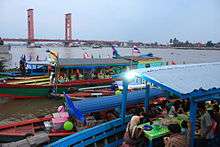
As a trading city since antiquity, Palembang is very heterogenous and its local culture and language is also influenced by many civilizations, most notably Chinese, Javanese, and Arabs. Several Dutch legacies in architecture can also seen in the city. The most notable landmarks in Palembang are Ampera Bridge, Musi River, Kuto Besak Fort, Kemaro Island, and Jakabaring Sport City.
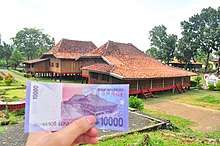
Landmarks and Sights
- Musi River, 750 kilometres (470 miles) long river which divides Palembang into two parts, which are Seberang Ulu and Seberang Ilir. It's one of the longest river in Sumatra. Since antiquity, the Musi River has become the heart of Palembang and South Sumatra's economy. There are some landmarks along its bank, such as Ampera Bridge, Kuto Besak Fort, Sultan Mahmud Badaruddin II Museum, Kemaro Island, 16 Ilir Market, traditional raft houses, Pertamina's oil refineries, Pupuk Sriwijaya (PUSRI) fertiliser plants, Bagus Kuning Park, Musi II Bridge, Kampong Al Munawar, etc.
- Ampera Bridge, main city landmark, is a bridge crossed over 1,177 metres (3,862 feet) above the Musi River which connects Seberang Ulu and Seberang Ilir area of Palembang.
- Great Mosque of Palembang, also known as the Sultan Mahmud Badaruddin II Mosque, is the main mosque of Palembang located in the city centre. This mosque is built as the royal mosque of Palembang Sultanate and had undergone several renovations during Sultanate, Dutch, and Republic rule.
- Kuto Besak Fort, located on the northern bank of the Musi River adjacent to Ampera Bridge and opposite to kampong Kapitan. The fort is built by Sultanate of Palembang, one of few surviving forts built by the local and not named after any European. Tourists are only allowed to see the fort from the outside as this fort is still owned by Tentara Nasional Indonesia, specifically the Health Department of Military Area Command II/Sriwijaya (Kesehatan Daerah Militer II/Sriwijaya) and has a function as a military hospital.
- Kemaro Island, a small delta island of Musi River, located in eastern Palembang. This island houses several Chinese heritages in Palembang which are Kemaro Island Pagoda and Hok Tjiang Rio temple (福正廟). This island becomes more crowded during Chinese festivals specifically during Cap Go Meh on the final day of Chinese New Year celebrations. In front of the temple, there is a tomb which is believed to be a tomb of a legendary couple of Tan Bun An and Siti Fatimah who made this island during their death.
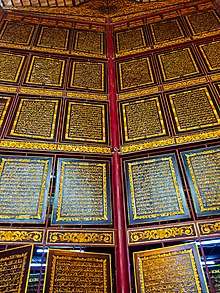
- Kampong Arab Al-Munawar, one of kampong in Palembang which is inhabited by Arab Indonesian descendants. This kampong is renowned by the kampong's architecture and culture which is a mixture of local Malay and Arab, especially from Hadhrami. It has been long known that any visitors should dress politely in order to visit this area.
- Kampong Kapitan, one of the oldest Chinese kampong in the city. The primary attraction is Tjoa Ham Hin's house with centuries-old furniture inside. There was also a nearby Chinese temple, which was one of the oldest in Palembang as well. Long before its existence as the Chinese settlement area, it was also called Tanggo Rajo where foreigners and newcomers from the archipelago stayed at.
- Kantor Ledeng, the mayor office of Palembang. It was originally built as a water tower during Dutch rule.
- Kambang Iwak, a pond located in Talang Semut close to Palembang mayor's residence. During Dutch rule, the area around the pond is the residence of Dutch people who works in the city, notable by European architecture on many houses around this pond and abundance of churches in this area. On the banks of this lake, there is a park and recreation arena which is always crowded by locals during weekends and holidays.
- Punti Kayu Tourism Forest, city forest located about six miles (9.7 kilometres) from the city centre with an area of 50 hectares (120 acres) and since 1998 designated as protected forests. In this forest there is a family recreation area and a local shelter a group of monkeys: long-tail macaque (Macaca fascicularis) and monkey (Macaca nemistriana) under the Sumatran Pine wood (Pinus mercussi).[92]
- Sriwijaya Kingdom Archaeological Park, the remnants of Sriwijaya site located on the banks of the River Musi. There is an inscription and stone relics, complex of ancient pond, artificial island and canals dated from the Srivijayan kingdom in this area. The Srivijaya Museum is located in this complex.
- Bukit Seguntang archaeological park, located in the hills west of Palembang city. One of the most major historical areas among the Malay community, it is believed that Sang Sapurba the progenitor all of the Malay Kings descended from this important hill. It is currently turned into a recreational park by the local government. The tombs of the Srivijayan royal family is also being located in the area.
- Monumen Perjuangan Rakyat / Monpera (People Struggle Monument), located in the city centre, adjacent to the Great Mosque and Ampera Bridge. Several relics during Indonesian National Revolution in South Sumatra are exhibited in this monument.
- Sultan Mahmud Badaruddin II Museum, is the former Dutch-era resident office located near the Ampera Bridge and adjacent to Benteng Kuto Besak. This museum located in the former royal palace of Palembang Sultanate which was demolished after Dutch conquest of Palembang. This museum exhibits several relics and historical objects with collections spanned from Srivijaya Kingdom period to Palembang Darussalam Sultanate era.
- Museum Balaputradewa, the home of Rumah Limas featured on IDR 10000 banknote. This type of stilt house is the traditional house of the people of Palembang.
- Rumah Limas Haji Aziz, a cultural home richly adorned with various traditional South Sumatran and Palembangese woodcarving. Visitors also have the option to dressed in the local classical attire in the abode.
- Al-Qur'an Al-Akbar, the Grand Quran of Palembang, a giant complete replica of the Muslim holy book. The 5-story quran is a prominent religious site in the area.
- Dekranasda Palembang, a collection of traditional Rumah adats from each South Sumatran regencies.
- Parameswara Monument, a large sculpture to commemorate Parameswara, the Sultan of Malacca from Palembang. The monument is also erected to celebrate the unity between various southeast Asian nations and the brotherhood spirit among the Malay community,
Festivals
- Bidar race, a traditional Malay rowing tournament is biannually held in Musi River especially on 17 August (Indonesia's Independence Day) and lesserly known 17 June (Palembang Establishment Day). Several bidar rowing teams will sprint across a stretch of Musi River from 35 Ilir Port to Ampera Bridge. The race is always accompanied with a boat carnival.[93]
- Ziarah Kubro, is a tradition held by several thousands of Muslims in Palembang before Ramadan by visiting several tombs of founding fathers, sultans and ulemas of Palembang Sultanate in Palembang.[94]
Culture
Since antiquity, Palembang has been a major port city in Southeast Asia which absorbs neighbouring, as well as foreign, cultures and influences. Throughout its history, Palembang has attracted migrants from other regions in the archipelago, and has made this city as a heterogenous city. Although today the city had lost its function as the major port city in the archipelago, the remnants of its heyday still evident in its culture. Palembangnese people mainly adopt culture which is mainly an amalgamation of Malay and Javanese customs.[95] Even now it can be seen in its culture and language. Word such as "wong (person)" is an example of Javanese loanword in Palembang language. Also the Javanese knight and noble honorific titles, such as Raden Mas or Raden Ayu is used by Palembang nobles, the remnant of Palembang Sultanate courtly culture. The tombs of the Islamic heritage was not different in form and style with Islamic tombs in Java.
Cuisine
Palembang cuisine is the second most well-known cuisine from Sumatra after Padang. They primarily use freshwater fish and prawn as ingredients due to the paramount role of the Musi River for the area. Spices are also generally included although not as liberal as its same-island counterpart. Malay, Indian, and Chinese culture has also influenced Palembang's culinary scene. Besides freshwater fish dishes, there are many variation of dishes, snacks, drinks, and sweets in Palembang cuisine. The most well known dishes in Palembang include pempek, tekwan, pindang patin, martabak HAR, and wide varieties of Bakmi which is a type of noodle dish. Numerous Palembang cuisines are highly influenced by Chinese culture.
Art
Textile
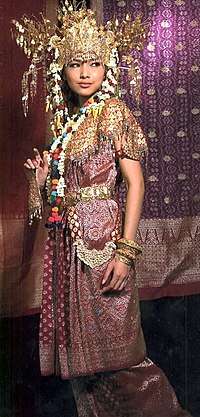
Palembang is mainly known for its artistic fabrics, songket. Songket is a hand-woven silk or cotton fabrics patterned with gold or silver threads.[96] It is a luxury product traditionally worn during ceremonial occasions as sarong, shoulder cloths or head ties and tanjak, a headdress songket. During Srivijaya rule, songkets were often used at the court.[97] Songkets are also traditionally worn as an apparel by the Malay royal families in Sumatra and the Malay Peninsular including Palembang Sultanate. Traditionally women are the weavers of songket, however in this modern time men also are known to weave it as well.[98] There are six main patterns in Palembang songket which are songket lepus, songket tawur, songket tretes mender, songket bungo pacik, combinated songket, and songket limar.[99] These patterns are not only used on songkets, but also as decoration for several structures in Palembang such as underpasses, flyovers, and bridges.[100][101][102]
Woodcarving
Palembang is also known for its woodcarving. Palembang woodcarving are heavily influenced by Chinese culture with motifs such as jasmine or lotus.[103] Palembang woodcarving style originally is used to wardrobe that stores songket fabrics. But nowadays it's often applied to house ornaments and also to many house applicants such as wooden display cabinets, wooden beds, aquariums, photo frames, mirrors, etc.[104]
Dance
Folk dances have been performed by Palembangnese since antiquity. The most known folk dance of Palembang is Tanggai Dance which was considered sacred in the past since it was performed as an offering to Shiva. Nowadays it was performed in a lot of important ceremonies and weddings.[105]
Theatrical Performance
In several occasions such as kenduri (communal feast), Palembangnese often hired several people to perform traditional theatrical performance called Dulmuluk, named after its main character, Raja Abdulmuluk Jauhari. Dulmuluk was known at first as a syair which was then adapted into local theatrical performance by Palembangnese in 1910. Dulmuluk often performed during night until the dawn of the next day.[106]
Sport
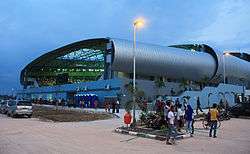
Palembang is notable as the host city 2018 Asian Games along with Jakarta, the first Asian Games hold officially by two cities and the fourth host city of Asian Games in Southeast Asia after Bangkok in 1998.[12] Palembang is also the main host of 2011 Southeast Asian Games and hosted two matches of 2007 AFC Asian Cup.[11][13][107] Sport facilities have been build across the city since 1971 to host Pekan Olahraga Mahasiswa (POM) IX, although the city's main sport complex, Jakabaring Sport City started its construction in 1998 and expanded later in 2010.[108][109] In order to keep the sport complex into frequent uses, several plans have been raised by the government to encourage more sporting events into the city, included the purchase of an association football club, Persijatim Solo F.C in 2004 which then renamed to Sriwijaya F.C.[110] Palembang also planned to build a race track inside the complex to host a MotoGP race in the city.[111]
Football is regarded as the most popular sport in Palembang. Sriwijaya F.C is the only active professional football club in South Sumatra and widely followed across the province, especially in Palembang as its home base. During its home matches, the stadium often flooded with fans wears yellow shirts on south stands, green shirts on north stands, and black shirts on east stands, representing three main ultras of the club. Badminton, basketball, volleyball and futsal also get some wide attention in the city. Beside Sriwijaya F.C., notable sport teams in Palembang are BSB Hangtuah (basketball) and Palembang Bank Sumsel Babel (volleyball). An Indonesian badminton player, Mohammad Ahsan and Debby Susanto is also from Palembang.[112][113]
Education
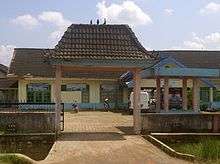
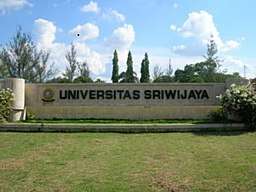
According to Ministry of Education and Culture, currently there are 462 elementary schools, 243 junior high schools, 140 high schools, and 80 vocational schools in Palembang; most of them are privately owned.[114] There are also 26 Islamic boarding schools or pesantren in Palembang as in 2015.[115]
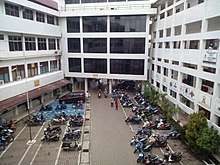
Many universities and colleges in South Sumatra are located in the city, the prestigious ones including Sriwijaya University, Raden Fatah State Islamic University, Sriwijaya State Polytechnic, Muhammadiyah University of Palembang and Bina Darma University.[116][117]
Other notable universities in Palembang are: Kader Bangsa University, IBA University, Indo Global Mandiri University, PGRI University, Tridinanti University, Musi Charitas University, and Indonesia Sport Polytechnic.[118]
Twin towns – sister cities






See also
- Musi language
- Srivijaya
References
- Indonesia's Population: Ethnicity and Religion in a Changing Political Landscape. Institute of Southeast Asian Studies. 2003.
- Data Sensus Penduduk 2010 - Badan Pusat Statistik Republik Indonesia <http://sp2010.bps.go.id/index.php/site/tabel?tid=321&wid=1600000000&lang=id>
- "Population by Religion in Palembang" (PDF). BPS. 2017.
- "Indonesia: Administrative Division of Sumatra (Regencies, Cities and Districts) - Population Statistics in Maps and Charts". citypopulation.de.
- "Kementerian PUPR Siapkan Pengembangan Metropolitan Baru Palembang Raya | Detak-Palembang.Com". Detak-Palembang.Com (in Indonesian). Archived from the original on 27 June 2018. Retrieved 6 May 2018.
- Munoz. Early Kingdoms. p. 117.
- Peter Bellwood, James J. Fox, Darrell Tryon (1995). "The Austronesians: Historical and Comparative Perspectives".CS1 maint: multiple names: authors list (link)
- Panji, Kemas A. R.; Suriana, Sri (2014). "SEJARAH KERESIDENAN PALEMBANG". Tamaddun (in Indonesian). 14 (2): 129–146. ISSN 1412-9027.
- Fernanda, Tyas (3 July 2015). "Tyas Fernanda Blog: Sistem Pemerintahan Kolonial Belanda di Keresidenan Palembang (1825-1942) Bagian II". Tyas Fernanda Blog. Retrieved 27 June 2018.
- "Palembang, Indonesia Panduan Wisata | Aktivitas di Palembang | Jetstar". www.jetstar.com (in Indonesian). Retrieved 6 May 2018.
- antaranews.com. "Kota Palembang Menjadi Tuan Rumah SEA Games 2011 - ANTARA News". Antara News (in Indonesian). Retrieved 6 May 2018.
- "Jakarta dan Palembang Resmi Menjadi Tuan Rumah Asian Games 2018". beritasatu.com (in Indonesian). 21 September 2014. Retrieved 6 May 2018.
- Media, Kompas Cyber (21 October 2009). "Palembang Siap Gelar Pembukaan SEA Games 2011 - Kompas.com". KOMPAS.com. Retrieved 6 May 2018.
- "Palembang ready to Operate 6 LRT Stations in July". Retrieved 27 June 2018.
- Media, Kompas Cyber (15 April 2017). "10 Destinasi Terbaik di Indonesia Tahun 2017 - Kompas.com". KOMPAS.com. Retrieved 27 June 2018.
- Industry.co.id (15 March 2018). "Sepanjang Tahun 2017 Kunjungan Wisatawan ke Palembang Melonjak 300 Persen - Industry.co.id". Industry.co.id. Retrieved 27 June 2018.
- "Kemacetan Lalu Lintas di Palembang Tambah Luar Biasa, Alex Noerdin Minta Warga Memahaminya - Sriwijaya Post". Sriwijaya Post (in Indonesian). 10 November 2016. Retrieved 27 June 2018.
- Media, Kompas Cyber (15 March 2018). "Terus Dilanda Banjir, Kota Palembang Butuh 60 Kolam Retensi - Kompas.com". KOMPAS.com. Retrieved 27 June 2018.
- Liputan6.com. "Permukiman Kumuh di Sela Bangunan Megah Pusat Palembang". liputan6.com. Retrieved 28 June 2018.
- "Sampah Numpuk Ditengah Sungai – SUARASUMSELNEWS". Retrieved 27 June 2018.
- Media, Kompas Cyber (11 April 2018). "Asian Games di Palembang Dihantui Bencana Kabut Asap - Kompas.com". KOMPAS.com. Retrieved 27 June 2018.
- Ikram, Achadiati, ed. (2004). Jati Diri yang terlupakan: Naskah-naskah Palembang (PDF). Jakarta: Yayasan Naskah Nusantara (Yanasa). p. 2.
- van Sevenhoven, J.L (1971). Lukisan tentang Ibukota Palembang (PDF). Jakarta: Bharata. p. 12.
- "Sejarah Kota Palembang".
- Hanafiah, Djohan (1995). Melayu-Jawa Citra Budaya dan Sejarah Palembang (PDF). Jakarta: PT Raja Grafindo Persada. p. 15.
- Eresen, Erik. "Menelusuri Sejarah Dari Nama Tionghoa Kota-Kota Di Indonesia". Retrieved 29 June 2018.
- George Coedès, Les inscriptions malaises de Çrivijaya, BEFEO 1930
- Coedès, George (1968). Walter F. Vella (ed.). The Indianized States of Southeast Asia. trans.Susan Brown Cowing. University of Hawaii Press. ISBN 978-0-8248-0368-1.
- Coedès, George (1918). "Le Royaume de Çrīvijaya". Bulletin de l'École Française d'Extrême-Orient (18 ed.). 6: 1–36.
- Nas, Peter J. M. (1995). "Palembang: The Venice of the East," in Issues in Urban Development: Case Studies from Indonesia. Leiden: CNWS. pp. 133–134.
- Andaya, Barbara Watson (1993). To Live as Brothers: Southeast Sumatra in the Seventeenth and Eighteenth Centuries. Honolulu: University of Hawaii Press.
- Munoz. Early Kingdoms. p. 151.
- The Cambridge Economic History of India: c.1200-c.1750 herausgegeben by Tapan Raychaudhuri, Irfan Habib, Dharma Kumar p.40
- Munoz. Early Kingdoms. p. 166.
- Schellinger, Paul E.; Salkin, Robert M., eds. (1996). Asia and Oceania: International Dictionary of Historic Places. New York: Routledge. p. 663. ISBN 1-884964-04-4.
- Ta Sen, Tan (2009). Cheng Ho and Islam in Southeast Asia. Institute of Southeast Asian Studies.
- "China's Great Armada – National Geographic Magazine". National Geographic. 15 May 2012. Retrieved 22 July 2012.
- Ardhani Reswari, 2013
- Zein, 1999
- Firmansyah, Rangga (10 November 2014). "VERNACULAR VALUE of KAMPUNG KOTA ( Case studi at Kampung Ulu Sattlement of Musi River, Palembang City)" (PDF).
- Yeo, Woonkyung (2012). Palembang in the 1950s: The Making and Unmaking of a Region. University of Washington.
- "The Battle for Palembang". www.dutcheastindies.webs.com. Retrieved 2 January 2016.
- "The Japanese Invasion of Sumatra Island". www.dutcheastindies.webs.com. Archived from the original on 3 December 2012. Retrieved 2 January 2016.
- Rickard, J (10 December 2007). "Boeing B-29 Superfortress Combat Record". History of War. Retrieved 22 August 2017.
- Iredale, W. The Kamikaze Hunters 2015 pp184-215 ISBN 9780230768192
- Notosusanto, Nugroho (2008). Sejarah nasional Indonesia: Zaman Jepang dan zaman Republik Indonesia, ±1942–1998. Balai Pustaka.
- Notosusanto, Nugroho; Poesponegoro, Marwatidjoened (1987). Sejarah Indonesia V. Balai Pustaka.
- Dimjati, M (1951). Sedjarah Perdjuangan Indonesia. Djakarta: Widjaja.
- Ricklefs, M.C. (2008). A History of Modern Indonesia Since C.1200. Palgrave Macmillan. p. 263.
- Reid (1974), pages 170–172; Ricklefs (1991), pages 232–233; "The National Revolution, 1945–50". U.S. Library of Congress.
- Imelda Akmal (Ed) (2010). Wiratman: Momentum & Innovation 1960–2010. Jakarta: Mitrawira Aneka Guna. ISBN 978-602-97997-0-5.CS1 maint: extra text: authors list (link)
- Winda, Heny (23 October 2012). "Kerusuhan Di Kota Palembang Pada Bulan Mei Tahun 1998 dan Dampaknya Terhadap Masyarakat Kota Palembang di Bidang Politik, Ekonomi dan Sosial (1998–2003)". UNSRI.
- "Dari Senayan ke Jakabaring | Republika Online". Republika Online. Retrieved 3 January 2016.
- "Keputusan Akhir, ISG Digelar di Palembang". detiksport. Retrieved 3 January 2016.
- Sasongko, Tjahjo (28 July 2014). "Setelah 1962, Jakarta Kembali Tuan Rumah Asian Games" – via kompas.com.
- "Walau Ada Sungai Musi, Palembang Belum Siap Jadi Kota Wisata Air". detiknews. Retrieved 3 January 2016.
- "Blog-SahatSimarmata: Visit Musi 2008". sahatsimarmata.blogspot.co.id. Retrieved 3 January 2016.
- "Gubernur Resmi Soft Opening Fly Over". Retrieved 3 January 2016.
- "Akhirnya Fly Over Simpang Jakabaring Dibuka". Sriwijaya Post. Retrieved 3 January 2016.
- "Ujicoba Transmusi". www.antaranews.com. Retrieved 3 January 2016.
- "Pemasangan tiang pancang LRT Palembang mulai dikerjakan". www.antarasumsel.com. Retrieved 3 January 2016.
- "FOTO: Jokowi Resmikan Ground Breaking Tol Palindra". SINDOnews. Retrieved 3 January 2016.
- "2 Fly Over Baru Akan Di Bangun Tahun 2016". www.sriwijayatv.com. Retrieved 3 January 2016.
- Okezone. "Resmikan Jalan Tol Palembang-Pemulutan, Jokowi: Ini yang Pertama di Sumatera Selatan : Okezone Economy". economy.okezone.com/ (in Indonesian). Retrieved 10 December 2017.
- "Keadaaan Geografis – Pemerintah Kota Palembang". palembang.go.id. Retrieved 10 January 2016.
- Argyantoro, Arvi; Samyahardja, Puthut; Medawaty, Ida. "Dampak Kenaikan Muka Air Sungai Di Kota Palembang". Pusat Penelitian dan Pengembangan Permukiman.
- "Iklim: Grafik iklim - Palembang, grafis Suhu, tabel Iklim - Climate-Data.org". id.climate-data.org. Retrieved 26 April 2016.
- Media, Kompas Cyber. "Tak Selamanya Indonesia Aman dari Badai Tropis Halaman all". KOMPAS.com (in Indonesian). Retrieved 14 September 2019.
- "Climate Palembang: Temperature, Climate graph, Climate table for Palembang - Climate-Data.org". climate-data.org.
- "Archived copy". Archived from the original on 17 October 2017. Retrieved 11 December 2015.CS1 maint: archived copy as title (link)
- "Archived copy". Archived from the original on 17 October 2017. Retrieved 11 December 2015.CS1 maint: archived copy as title (link)
- Media, Kompas Cyber. "Suap Akil Mochtar, Wali Kota Palembang dan Istrinya Dituntut 9 dan 6 Tahun Penjara - Kompas.com". KOMPAS.com. Retrieved 14 December 2017.
- "Direktori" (in Indonesian). Pemerintah Kota Palembang. Retrieved 24 November 2016.
- "Beranda" (in Indonesian). Pemerintah Kota Palembang. Retrieved 24 November 2016.
- "Badan Pusat Statistik". palembangkota.bps.go.id. Retrieved 14 December 2017.
- Julheri (3 August 2017). "Kecamatan Jakabaring dan Ilir Timur III Siap Diresmikan | Sumatera Ekspres". Sumatera Ekspres (in Indonesian). Retrieved 14 December 2017.
- "Population by Religion in Palembang" (PDF). BPS. 2017.
- "Population by Region and Religion in Indonesia". BPS. 2010.
- "Melirik Transportasi Palembang Dari Masa ke Masa". Terminal Lemabang. 24 March 2014. Retrieved 10 December 2017.
- Alexander, Hilda B (22 October 2016). "LRT Palembang Beroperasi Juni 2018" [Palembang LRT will operate in June 2018]. Kompas (in Indonesian). Retrieved 29 October 2016.
- "Badan Pusat Statistik". palembangkota.bps.go.id. Retrieved 31 December 2017.
- "Kota Palembang Dalam Angka 2017" (PDF). BPS Kota Palembang. Statistics Indonesia. Retrieved 22 August 2017.
- Raslan, Karim (12 January 2017). "As Sumatra dives into modern economy, a boatman struggles". South China Morning Post. South China Morning Post. Retrieved 22 August 2017.
- M.Plan, Entatarina Simanjuntak, ST; ST, Zagita Heryani Putri; ST, Menik Wahyuningsih; ST, Aditya Wilis Yogatama Nugraha; ST, Andri Budi Wicaksono; S.AP, Erlangga Dwiharjanto; ST, Dian Septa Rianti (17 May 2017). Strategi dan Rencana Pengembangan Infrastruktur Pekerjaan Umum dan Perumahan Rakyat (PUPR) di Pulau Sumatera Tahun 2015-2025 (in Indonesian). Pusat Perencanaan Infrastruktur Pekerjaan Umum Dan Perumahan Rakyat. ISBN 9786027473249.
- "Stockpile Batubara Jadi Kendala Kimerogan Jadi Lokasi Wisata Religi - Tribunnews.com". Tribunnews.com (in Indonesian). Retrieved 2 January 2018.
- "Produksi Karet menurut provinsi di Indonesia, 2013-2017" (PDF) (in Indonesian). Departemen Pertanian.
- Ertina, Nila (4 September 2014). "Produksi pabrik karet Palembang turun" (in Indonesian). ANTARA Sumsel. Retrieved 22 August 2017.
- Rahayu, Slamet Teguh (6 December 2016). "Gandus Bakal Jadi Pusat Industri Karet, Sawit dan Lainnya di Palembang" (in Indonesian). Tribunnews. Retrieved 22 August 2017.
- Siregar, Raja Adil. "Ekspor Pempek ke Luar Palembang Tembus 1 Ton/Hari". detiknews. Retrieved 31 December 2017.
- "Pasar tradisional di kota Palembang - Bulletin Metropolis". Bulletin Metropolis (in Indonesian). 8 January 2009. Retrieved 3 January 2018.
- "Nasib Cagar Budaya Pasar Cinde Tunggu Kajian Tim Pelestarian | Republika Online". Republika Online. 11 October 2017. Retrieved 2 January 2018.
- "Punti Kayu: Sumatran Jungle Tours in Palembang, South Sumatera". 1 December 2011.
- Planet, Lonely. "Bidar Race in Palembang, Indonesia". Lonely Planet. Retrieved 4 May 2018.
- Media, Kompas Cyber (3 June 2017). "Ziarah Kubro, Tradisi Khas Palembang Halaman 1 - Kompas.com". KOMPAS.com. Retrieved 4 May 2018.
- Yunita, Citra (14 April 2016). "Peranan Pangeran Surya Kusuma Muhammad Arsyad dalam Mengembangkan Islam di Palembang". E-Prints Universitas Islam Negeri Raden Fatah.
- Ivonesuryani. "Terpesona Lembaran Kain Sumatera Selatan". detikTravel. Retrieved 3 January 2018.
- "The Art of Songket". Archived from the original on 26 January 2008.
- Rodgers, Susan; Summerfield, Anne; Summerfield, John (2007). Gold Cloths of Sumatra: Indonesia's Songkets from Ceremony to Commodity. KITLV Press. ISBN 9789067183123.
- "Jenis-jenis Motif Kain Songket Palembang". Songketaslipalembang (in Indonesian). 4 February 2011. Retrieved 3 January 2018.
- "Underpass Simpang Patal-Pusri Mulai Rusak. Motif Batik Mengelupas, Gambar Orang Menenun Lumutan - Sriwijaya Post". Sriwijaya Post (in Indonesian). Retrieved 3 January 2018.
- "Pemasangan Motif Songket Fly Over". sumsel.antaranews.com. Retrieved 3 January 2018.
- "Empat Pilar Jembatan Musi IV Bermahkota Tanjak - Sriwijaya Post". Sriwijaya Post (in Indonesian). Retrieved 3 January 2018.
- "Melihat Eloknya Kerajinan Ukir Khas Palembang | Hello PALEMBANG". Hello PALEMBANG. 28 May 2015. Retrieved 3 January 2018.
- "Seni Ukir Khas Palembang". ragapnian (in Indonesian). 13 May 2015. Retrieved 3 January 2018.
- Saputra, Muhammad Juniussava; Taqwa, M. Ridhah; Nomaini, Faisal (May 2016). "TARI TANGGAI DAN HABITUS MASYARAKAT PALEMBANG". Jurnal Empirika. 1: 83–100 – via Portal Garuda.
- "Inilah Kisah Awal Munculnya Teater Dul Muluk | | Laskar Wong Kito". Laskar Wong Kito. 11 January 2017. Retrieved 4 May 2018.
- "Final 3-4 Piala Asia di Palembang". sepakbola. Retrieved 6 May 2018.
- "Pekan Olah Raga Mahasiswa IX Palembang Tahun 1971". www.palembangdalamsketsa.com. Retrieved 6 May 2018.
- Wahyudi, Rendra. "Stadion Jakabaring" (in Indonesian). Retrieved 6 May 2018.
- "Mengapa Klub-Klub Indonesia Mudah Pindah dan Berganti Nama?". FourFourTwo (in Indonesian). 13 April 2016. Retrieved 6 May 2018.
- Liputan6.com. "Palembang Optimistis Jadi Tuan Rumah MotoGP 2019". liputan6.com. Retrieved 6 May 2018.
- "Mohammad Ahsan - WowKeren.com". WowKeren. Retrieved 6 May 2018.
- VIVA, PT VIVA MEDIA BARU- (5 October 2017). "Profil Debby Susanto - VIVA". www.viva.co.id (in Indonesian). Retrieved 15 December 2018.
- "Data Referensi Pendidikan". referensi.data.kemdikbud.go.id. Retrieved 7 May 2018.
- "REKAPITULASI JUMLAH LEMBAGA PONDOK PESANTREN SE PROVINSI SUMATERA SELATAN TAHUN 2015" (PDF).
- "100 Universitas Terbaik di Indonesia Tahun 2018, Daftar Terbaru!". www.halomoney.co.id (in Indonesian). Retrieved 11 May 2018.
- "100 Besar Perguruan Tinggi Non Politeknik dan 25 Besar Perguruan Tinggi Politeknik di Indonesia Tahun 2017". ristekdikti (in Indonesian). Retrieved 11 May 2018.
- "Perguruan Tinggi". ristekdikti (in Indonesian). Retrieved 11 May 2018.
- "Domo frente a la Terminal de transportes de Neiva es símbolo de la unión con Indonesia" (in Spanish). El Tiempo. 17 May 2010. Retrieved 22 August 2017.
- "The Indonesian twin sister of Venice: Palembang" (in Italian). Facciunsalto.it. 20 June 2016. Retrieved 4 February 2019.
External links
| Wikimedia Commons has media related to Palembang. |
- Official website – in Indonesian

